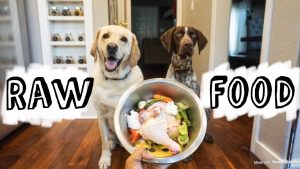
Introduction
As we continue to learn more about the food we eat and its effects on our health, the same applies to our pets. Raw food diets for pets have become increasingly popular in recent years. These diets, which include fresh, unprocessed ingredients, are thought to provide pets with natural nutrients and health benefits that processed food cannot offer.
In 2025, more pet owners are shifting towards raw food diet plans to give their pets the healthiest and most balanced meals possible. This article will explore the long term benefits of raw food diets, share tips for creating meal plans, and provide advice on how to implement this diet for your furry friends.
What Is a Raw Food Diet for Pets?

A raw food diet for pets typically consists of unprocessed, fresh foods, often referred to as biologically appropriate raw food (BARF). This diet is based on the idea that pets, especially dogs and cats, thrive on the same kind of food they would eat in the wild, such as raw meats, olive oil, bones, fruits, dairy products and vegetables.
Raw food diets exclude processed ingredients and focus on natural foods that are rich in essential nutrients. These meals are meant to mimic the diet of wild animals, helping to promote better digestion, improved energy, and healthier coats for pets.
The main components of a raw food diet for pets usually include:
- Meat: High-quality, raw meat such as chicken, beef, lamb, or turkey.
- Bones: Raw, edible bones that provide calcium and help keep teeth clean.
- Vegetables and Fruits: Fresh vegetables like carrots and spinach, and fruits like apples and blueberries.
- Supplements: Occasionally, specific vitamin and mineral supplements are added to ensure pets get all their necessary nutrients.
How to Create a Raw Food Diet Plan for Your Pet in 2025

Creating a balanced raw food diet plan for your pet involves selecting the right ingredients and ensuring they get the necessary nutrients. Here’s how to get started:
1. Choose High-Quality Proteins
The foundation of any raw food diet is protein. Opt for fresh, high-quality meats that are free from hormones and antibiotics. Some good choices include:
- Chicken
- Turkey
- Beef
- Lamb
- Duck
Always choose meat that is safe for pets to eat raw. Avoid meats that could be harmful, such as pork, which may carry parasites.
2. Incorporate Edible Bones
Bones are an essential part of a raw food diet, as they provide important minerals, including calcium. They also promote oral health by helping clean the teeth. Make sure the bones you provide are raw and not cooked, as cooked bones can splinter and cause harm to your pet.
3. Add Vegetables and Fruits
While pets are primarily carnivores, they can also benefit from small amounts of vegetables and fruits. These provide important vitamins and fiber that aid in digestion. Some good options for vegetables include:
- Carrots
- Spinach
- Kale
- Zucchini
Fruits like apples (without seeds), blueberries, and watermelon can also be added in moderation. Be sure to avoid feeding your pet toxic foods like grapes, raisins, or onions.
4. Include Supplements for Balanced Nutrition
Depending on your pet’s age, breed, and specific health needs, you may need to add supplements to their raw food diet. Common supplements for pets on a raw food diet include:
- Fish oil for omega-3 fatty acids.
- Probiotics for gut health.
- Vitamin E for skin health.
- Calcium (if not provided by bones).
Consult a veterinarian to ensure your pet is getting the right balance of nutrients from their raw food diet.
5. Monitor Portion Sizes
Just like with any diet, it’s important to feed your pet the right portion sizes. Overfeeding or underfeeding can lead to health problems. Most pet owners feed their dogs and cats about 2-3% of their body weight per day, depending on their activity level and health.
Common Mistakes to Avoid When Feeding Your Pet a Raw Food Diet

Feeding your pet a raw food diet can be beneficial, but it’s important to avoid certain mistakes that can lead to health problems:
- Not Consulting a Veterinarian: Before starting your pet on a raw food diet, consult a veterinarian to make sure it’s the right choice for their health and well-being.
- Feeding Only Meat: A balanced diet for pets includes more than just meat. Be sure to add vegetables, fruits, and appropriate supplements to ensure they get all the necessary nutrients.
- Using Dangerous Ingredients: Some foods, like onions, garlic, and chocolate, are toxic to pets. Always check that the ingredients you choose are safe for your pet.
- Not Preparing Food Properly: Raw food should always be handled carefully to prevent contamination. Store raw meat properly and wash your hands and utensils after handling raw food.
Future of Raw Diets for Pets in 2025 and Beyond

Looking forward, raw feeding will become easier and safer thanks to innovation and research. Meal-prep services will deliver pre-measured, vet-approved raw packs, cutting down on prep time and guesswork. Smartphone apps will scan product barcodes to confirm nutritional balance and source quality. New studies will refine ideal ratios of muscle meat, organ, and bone for different breeds and life stages. As more tools and expert guidance reach the market, raw diet plans will continue to grow, giving pets a natural, health-focused path well into the future.
Comparative Table: Key Ingredients in a Raw Food Diet and their Benefits For Pets
| Ingredient | Benefits | Examples |
|---|---|---|
| Meat (Protein) | High-quality protein, essential for muscle growth | Chicken, turkey, beef, lamb, duck |
| Edible Bones | Provides calcium, cleans teeth | Raw chicken wings, turkey necks |
| Vegetables | Provides fiber, vitamins | Carrots, spinach, kale, zucchini |
| Fruits | Adds vitamins and antioxidants | Apples (without seeds), blueberries, watermelon |
| Supplements | Ensures balanced nutrition | Fish oil, probiotics, calcium, vitamin E |
Conclusion: Why Raw Food Diets Are the Future of Pet Nutrition
In 2025, the popularity of raw food diets for pets is continuing to rise. With their focus on natural ingredients, high-quality proteins, raw veganism, and ethical practices, sustainable and nutritious diets for pets are becoming a preferred choice for many pet owners. Whether it’s improved digestion, healthier coats, or stronger immune systems, the benefits of a raw food diet for pets are clear.
By making informed choices and carefully planning meals, pet owners can give their furry friends the healthiest food possible. A well-balanced raw food diet can help pets live longer, healthier lives.










